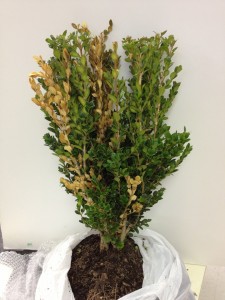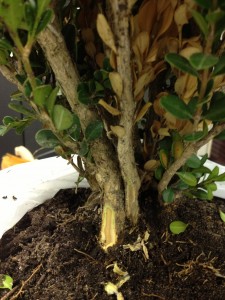A quick wrap of things seen in the last couple of weeks as temperature begin to get cooler. At the Plant Clinic, we have some samples with root rot damage. These are root rots of all kinds, occurring on woody ornamental and turf grasses. Why is there a pickup in the incoming samples? There is not an easy answer. It may be that since weather is getting cooler, more people are out in their yards -resulting in greater observations of the damage in the landscape. Another explanation could be that the moderating temperature is conducive to the pathogens that can cause root rot.
With turf grasses, cooler weather also means more moisture in the soil. Moisture is favored by most fungal pathogens. Couple with the same sprinkler program, there is now even more water in the soil. Not to mentioned that the grasses may have endured the hot summers and may be a little weaken. All these factors can contribute to successful attack by pathogens. Check out Texas A&M AgriLife Extension Service publication E-306 by Drs. Jo and Camerino (Warm-season turfgrass disease management in urban landscapes). This is a publication with lots of good information about turf grass diseases, more than just root rots (aka patch diseases).

Boxwood with dead branches as a result of root rot
Similarly with woody ornamentals, root and crown attacking pathogens can infect a plant (usually a stressed one) and result in the eventual death or stunting. We have found various fungal agents such as fusarium, thelaviopsis and phytophthora causing root rot on landscape ornamentals. A good way to figure out if you are dealing with a root rot is to look at the roots of the affected plants. If the roots are bad looking (brown-black, sloughing off), that is a pretty strong indication that you may be dealing with root rot. In some instances, the pathogen can also cause vascular damage – resulting in wilting prior to collapse.

Vascular system damage. On left is a healthy stem (note: whitish-green tissue). On the right is the a dying/dead branch with darken vascular tissue.
What can you do about it? First, evaluate growing area to make sure that you are not dealing with poor drainage or excessive water situations. If you are, try to remedy those deficiencies. Second, lay OFF the high nitrogen fertilizers. Many of us sometimes mistakenly think that if we can encourage the plant to be vigorous, it might just outgrow the disease. While there is some merit to this thinking, high nitrogen will tend to encourage foliar growth. This may put additional strain to the plant’s root system to gather nutrients and stressing out the plant even more. Appropriate fungicides or natural supplements (such as compost or compost tea), may help to lessen the impact of the disease on the plant. When damage is seen in the canopy of the plant, the damage in the root are pretty extensive. Sometimes the plant can recover, sometime is does not.


